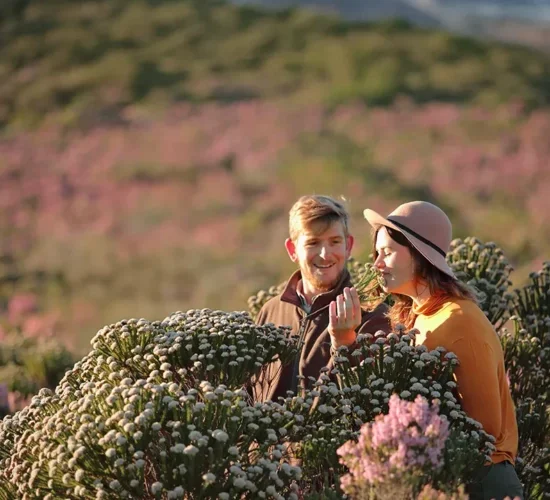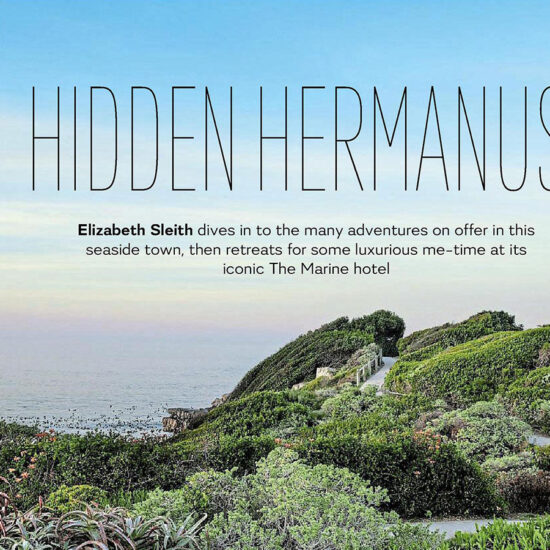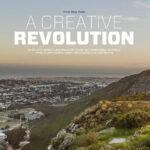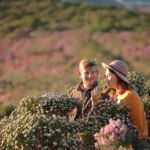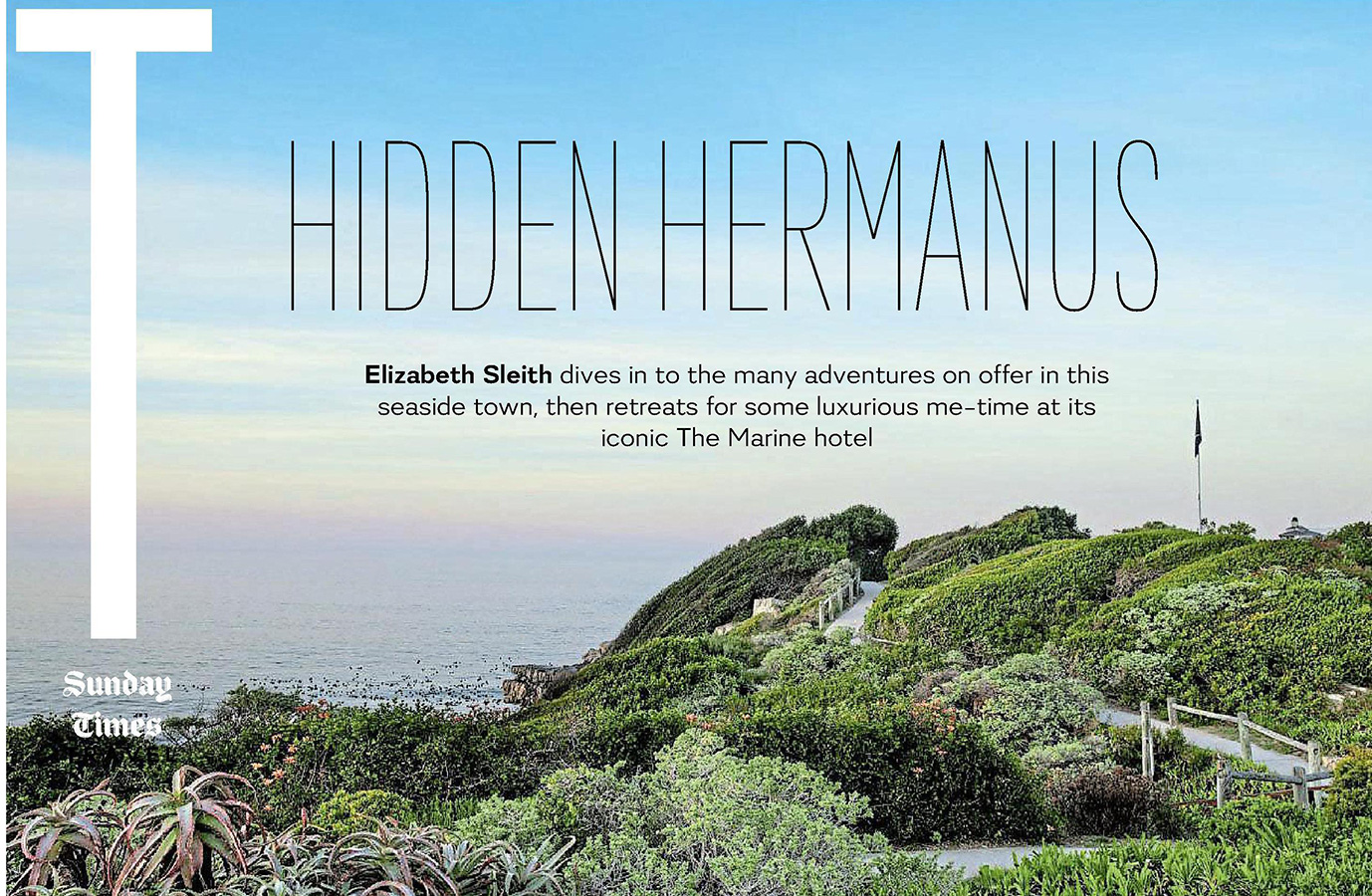
Hidden Hermanus
The Hermanus cliff path hugs the coastline and overlooks the blue belly of whaleplayground Walker Bay, above. Picture SUPPLIED
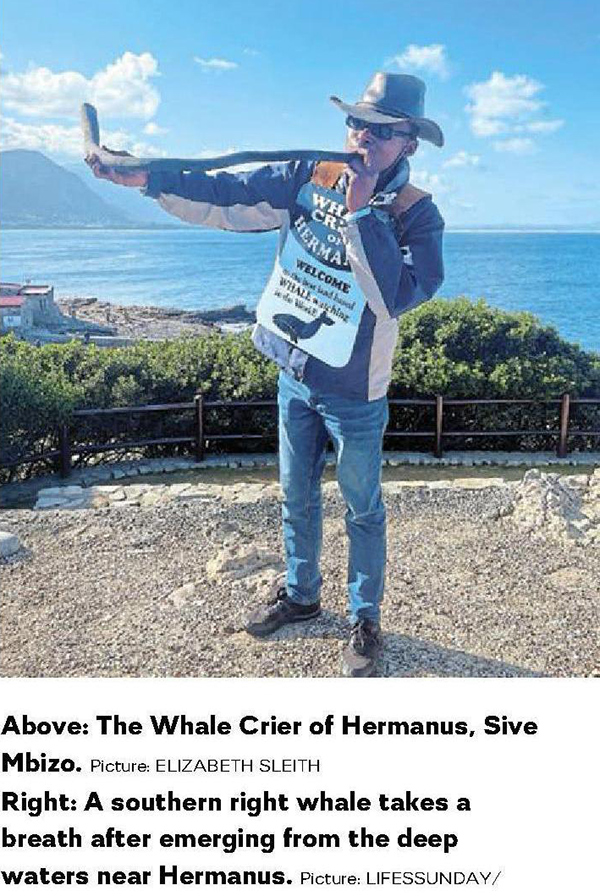 Sive Mbizo has the best job in the world. So he says, anyway. Standing on the edge of Hermanus, looking at the pretty coastal path that wanders seemingly all the way to Gansbaai in the distance, and the cliffs that drop off to the wide blue belly of Walker Bay inbetween, it’s hard to quibble. For six months of the year, this is his office. His role? To scan the sea for the whales that migrate here from Antarctica to breed, get their babies “up and swimming” and play in the shallow waters. Should he spot one, his duty is to announce the news come one, come all! on his special kelp horn.
Sive Mbizo has the best job in the world. So he says, anyway. Standing on the edge of Hermanus, looking at the pretty coastal path that wanders seemingly all the way to Gansbaai in the distance, and the cliffs that drop off to the wide blue belly of Walker Bay inbetween, it’s hard to quibble. For six months of the year, this is his office. His role? To scan the sea for the whales that migrate here from Antarctica to breed, get their babies “up and swimming” and play in the shallow waters. Should he spot one, his duty is to announce the news come one, come all! on his special kelp horn.
As the official Whale Crier of Hermanus,Mbizo is a sort of summertime Santa, a man everyone is happy to see. No wonder he loves his job. We meet in early June at the start of whale season. He talks zestily about the waters here, which offer the “best land-based whalewatching in the world”.
On a good day, they bob about in their hundreds. On a bad? He does feel pressure to deliver. He tells a story about how once, with no whales in sight, he’d walked far, far out of town along the path 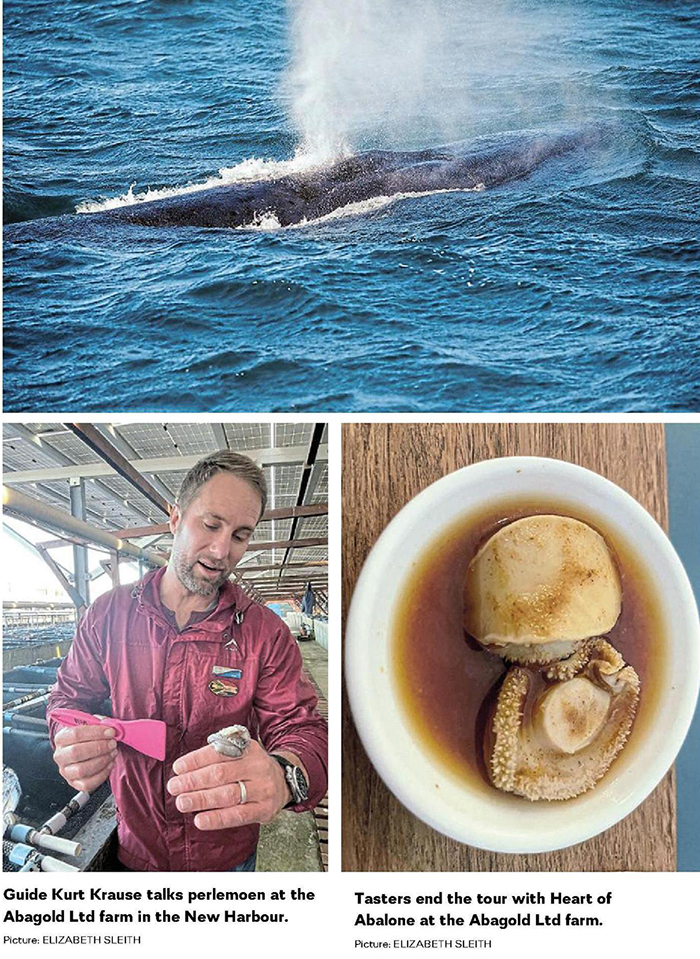 and just as an experiment blown the horn. Suddenly, a mother and her calf appeared. “I’m not saying I can call the whales,” he says, “but …”. He shrugs, and lets the sentence fall away into the sea. And though “crying wolf” is clearly against the rules, he risks the wrath of passers-by to demo the sound.
and just as an experiment blown the horn. Suddenly, a mother and her calf appeared. “I’m not saying I can call the whales,” he says, “but …”. He shrugs, and lets the sentence fall away into the sea. And though “crying wolf” is clearly against the rules, he risks the wrath of passers-by to demo the sound.
His quick pip on the horn is deep and delightful. For the record, no whales arrive. They are definitely out there, though, as proven on a morning outing with Southern Right Charters.
A quick lesson before departure and we know there are three main types we can hope for: humpbacks, Bryde’s and southern rights.
We pile onto a catamaran called Miroshca and head out to sea. Not terribly far out and in no time at all, we are bobbing beside a Bryde’s whale. To the naked eye, from a boat, it’s only a shiny blob briefly breaking the surface. But a drone flying overhead allows the guide not only see the creature in its entirety but also to see when it’s about to breach, and where. “Eleven o clock folks” he shouts. By the time it emerges, eyes and cameras are already in the right place. This is the first of a few we see, and it’s a thrilling morning spent telling the time in whale parts: the flash of a back, the arc of a fin and, now and again, the most wonderful final flourish of a Super-Mario-moustache tail slapping the water.
See southernrightcharters.co.za
HOW DO I GET YOU, ABALONE?
For those who like their sea celebrities smaller, shinier and edible, Hermanus lays claim to another creature abalone or, as we in SA call it, perlemoen. Highly prized at dinner tables but dwindling drastically in the wild, abalone has been farmed in South Africa since the mid1980s. Today, the country has about 20 farms, which send more than 1,000 tonnes of “white gold” per year to the Asian market.
One of the largest operations is Abagold Ltd, whose tourism partner, Heart of Abalone, offers deep dives into the workings of a farm in Hermanus’s New Harbour. Not surprisingly, security is tight and hygiene is serious business. Our group must tug on white wellies and promise not to touch anything before we go behind the gates to see giant pipes pumping seawater to fields of tanks. Inside, the shiny, slimy, shy creatures huddle at various stages of development. Here is a baby, here is a male … Guide Kurt Krause periodically picks one up and holds it aloft while we all become experts on the little sea snails.
Consider, for example, the sorry state of their love lives. They are “broadcast spawners”, meaning that, come sexy time, males and females release their sperm and eggs into the water. Procreation happens without contact. Also, it’s rising water temperatures that start it all. As Krause puts it, “They breed because they think they’re dying.” Poor things, but it is handy intel for the farmers as it’s how they get them breeding: by raising the water temperatures. Every Thursday, for the record, is a babymaking day for the abalone.
The tour ends with tasting bites: minced, dried and fresh. Having just cooed over their babies and learnt about their sex lives, I am hesitant but eat them anyway, curious to know what all the fuss is about. An acquired taste. I’ll say, and maybe it’s no accident that, in Asia, abalone is a popular gift to give one’s motherinlaw.
See heartofabalone.co.za
GOING, GOING GASTRONOMY
The town has much more to offer, though, if it’s foodie attractions you’re after. In fact, in 2019,Hermanus, with the greater Overberg region, was named a Unesco Creative City of Gastronomy, the only one in Africa. There are various qualifying criteria, but in short it’s about its authentic ingredients, sustainability practices and excellent wines. A good starting point for exploring some of this is Susan Mann, who runs walking tours through Eat Like a Local. And while tourists naturally gravitate to the slew of spots overlooking the bay, Mann’s tours aim to unspool the town “one bite at a time” and especially to show off some of its offthemaindrag highlights. Our tour kicks off at Onshore Eatery, with a demonstration of sourdough breadbaking.
At Mikro Coffee, we taste brews paired with sweet bites and hear coffee’s origin story it starts with an Ethiopian goat herder.
Hame, a wacky combo of cafe and whisky lounge, we meet owner Emilia Knight, who shares the hardwon secret to her brilliant croissants it’s French butter . Next is a popin at the Dal-Italia deli to buy cheeses, which we unwrap around the corner at Wine and Co to go with wines tasted from nearby farms.
There’s more locally sourced and organic at The Station restaurant, with teas from Christine Stevens Harvest, and the final stop is at Char’d, a steakhouse on a mission to use as much of the carcass as possible. Here, we taste a few less familiar cuts paired with brandies. It’s a packed morning of meeting people who are all fired up about their foodie pursuits, and getting to taste their wares.
Everyone leaves with a long list of places to return to.
See eatlikealocal.co.za/a-taste-of-hermanus
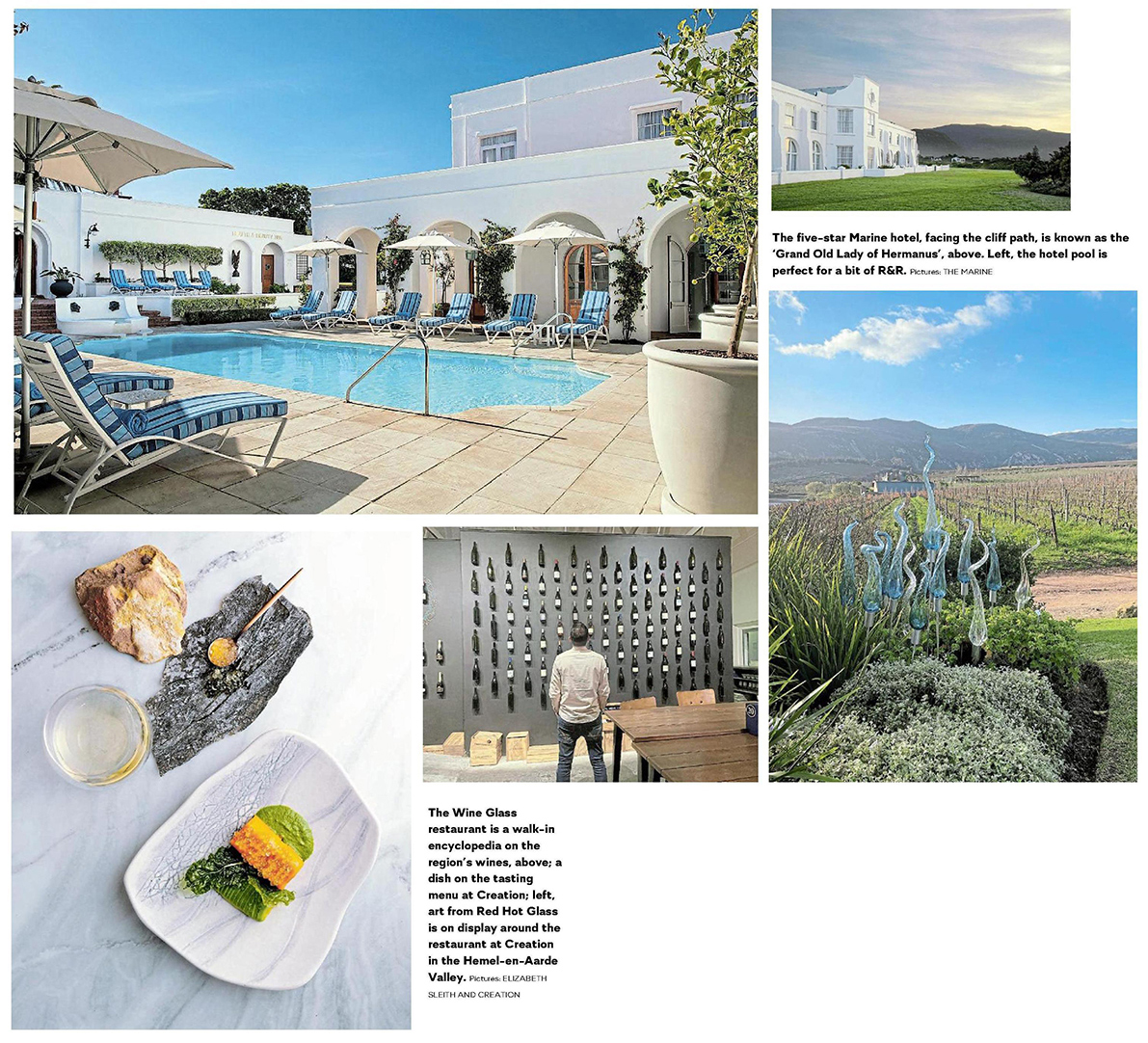
THE GREATEST GRAPES
For more wine tourism, The Wine Glass restaurant is worth a stop. Delicious dinner but also for a chance to taste around 100 of the region’s wines. Bottles are even part of the decor and our sweet sommelier, over a tasting of six, imparts tricks like how to test for tannins with your mouth and fun facts, like pinot noir a local speciality is known as the heartbreak grape because it’s so fussy to farm. See thewineglass.guru/hermanus
The apex wine experience, however, is on the R320, which meanders through the Hemel-en-Aarde valley. It is home to several respected vineyards, but only one was named fourth best in the world for wine tourism by the World’s 50 Best Vineyards to Visit , and that is Creation.
That’s just one of a cabinet full of awards it has taken and deservedly so. Our wine pairing lunch here is like nothing I’ve ever experienced. Its five courses based on ayurvedic principles are a dance with different flavours, but also with health and creativity. One part, for example, is a “shellphone tasting”, where we hold a shell to our ears and sip a wine at the same time. It’s a “hear the ocean, taste the ocean” moment since the grapes are shaped in part by the sea air.
As we wander through the courses, owner Carolyn Martin talks sincerely about the importance of happy teams, healthy vines and sustainable practices that will keep the soil producing great grapes for generations. The toil of launching a vineyard from scratch without chemicals came with a payoff for which she and her husband, coowner JC Martin, waited years.
Now their flagship wines are chardonnay and pinot noir yes, the heartbreak grape. And yes, there are tears, but happy ones. French winemakers, Carolyn says, have fallen on their knees and wept when they’ve seen the pristine state of the plants.
See creationwines.com
GIMME SOME SPACE
There’s science of a different kind at the SA National Space Agency Sansa , one of whose major tasks is to monitor the Earth’s magnetic field for changes that may affect our technologies. This 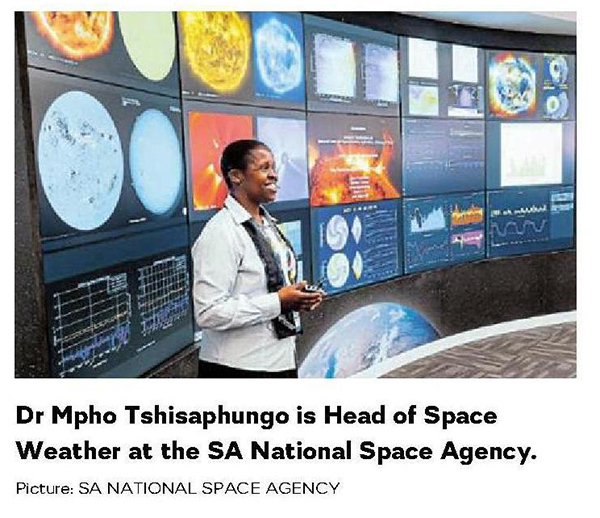 magnetic observatory has been here since 1940 booted out of Cape Town by the electric railway, which played havoc with its sensitive measuring instruments. Hermanus has no railway line . The facility also runs Africa’s only Space Weather Centre.
magnetic observatory has been here since 1940 booted out of Cape Town by the electric railway, which played havoc with its sensitive measuring instruments. Hermanus has no railway line . The facility also runs Africa’s only Space Weather Centre.
On a tour, we meet Dr Mpho Tshisaphungo, whose cool job title certainly gives the Whale Crier a run for his money: she is the Head of Space Weather. In front of a huge bank of flashing monitors, she explains what space weather is and why it matters. Again, it has to do with events in space whacking out Earthly technologies such as planelanding systems.
We also meet electronic engineer DJ Van Wyk full of mindboggling tales as he’s just returned from a long stint at South Africa’s research base in Antarctica and peek in at the science centre, which aims to inspire “SA’s first generation of astronauts” with displays like the actual space suit worn by the second woman in space.
There’s also an opticalillusion photo op that guarantees giggles. See sansa.org.za
METIME AT THE MARINE
With days so full, the iconic Marine hotel, aka the “Grand Old Lady of Hermanus”, proves the perfect base for some metime inbetween. Facing onto the famous cliff path and the Whale Crier’s office , The Marine is a quick stroll from the sea, and on good days guests might enjoy whalespotting from their very bedrooms.
Its history dates back to 1902, when the town first started drawing wellness tourists with its “champagne air”. Today, they enjoy the impeccable style legacy of the late Liz McGrath, who managed to give it a simultaneously opulent and homely air, with polished service and divine meals in the Pavilion restaurant under head chef Oelof Vorster.
There’s also a heated swimming pool in a peaceful courtyard, a tidal pool directly in front of the hotel, a health and beauty spa and a boutique.
SPECIAL OFFER:
The Marine has a special Wellness Escape available until the end of September. It includes a threecourse dinner, breakfast and two treatments in the spa per person. R8,000 per night for two people sharing.
Sorry, the comment form is closed at this time.

